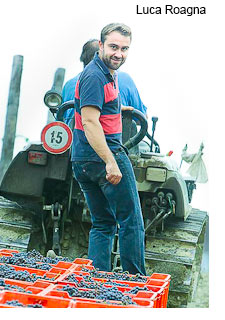
'Roagna's 2012 Barolos and Barbarescos are off the charts.'
- Antonio Galloni
The Roagna family are fanatical environmentalists with a long history. They trace their ownership of vineyards back to the early nineteenth century and were one of the first families to produce Barbaresco in 1880, though it wasn't officially classified until 1890. These are thrilling wines of high emotion, underpinned by daringly natural farming and intelligent, hands-off cellar work. Located in both Barbaresco and Barolo, their vineyards occupy some amazing terroirs, which directly influence the flavour and quality of their wines. No pesticides, herbicides or fertiliser are used on this precious Nebbiolo, though a little compost is applied every four or five years.
Having grown their fruit with virtually no inputs, Luca is able to use the natural yeasts on the grapes for the ferment and for many of us who adore these wines that's another element of terroir transparency; it's a great indication of the health and vitality of the vines. In the cellar, Alfredo and Luca Roagna (4th and 5th generations respectively) take full advantage of the care and constant monitoring they've done over the growing season. They use gentle, traditional vinification methods, with the cap of grapes submerged and left to extract gently over anything between 70-100 days. This results in mineral and super-silky wines that are as structured and fresh as they are perfumed and long. Recently Luca has tweaked the cask ageing with a little less time in barrel, and the additional purity they now show gives them an even finer edge.
The Roagna portfolio is extraordinary and has been for years; it's not all about the Barolo and Barbaresco. The Nebbiolo for the Langhe Rosso comes entirely from Cru vineyards in Barolo and Barbaresco: roughly 2/3 Pira, 1/3 Paje. It is understandably better than a lot of people's Barolo. The Barbera, some of it planted 80 years ago and the rest just over 30, is more about Pira terroir than the grape. It has a big structure but is soft and drinking wonderfully now. The Dolcetto gets 3 months skin contact and had only been racked off the skins a few days before my visit. I say skins, apparently the grapes were still intact. It has saline minerality and Christmas spice among its flavours. The balance on all these bottlings is little short of exquisite. If you buy no other Barolo or Barbaresco from this vintage, you need at least one of Roagna's wines. After all, as Kerin O'Keefe said, they are 'handcrafting fascinating, soulful Barbarescos and Barolos of mesmerising depth'. /CW
Offered subject to remaining unsold; available imminently
| Vintage | Description | Cs Sz | Bt Sz | Cs | Bts | Cs ib | Cs inc | Bt inc | ||
|---|---|---|---|---|---|---|---|---|---|---|
| 2012 | Roagna Barbera d`Alba | 6x | 75cl | 0 | 0 | Buy | ||||
| 2016 | Roagna Dolcetto d`Alba | 6x | 75cl | 0 | 0 | Buy | ||||
| 2012 | Roagna Barolo Pira Vecchie Viti | 6x | 75cl | 0 | 0 | Buy | ||||
| 2012 | Roagna Langhe Rosso | 6x | 75cl | 0 | 0 | Buy | ||||
| 2012 | Roagna Barbaresco Paje | 6x | 75cl | 2 | 0 | £390.00 | - | - | Buy | |
| 2012 | Roagna Barbaresco Paje | 3x | 150cl | 0 | 0 | Buy | ||||
| 2012 | Roagna Barbaresco Paje Vecchie Viti | 6x | 75cl | 0 | 0 | Buy | ||||
| 2015 | Roagna Montemarzino Timorasso | 6x | 75cl | 0 | 0 | Buy |